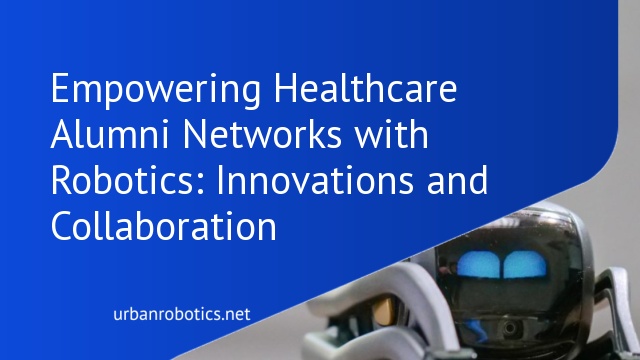Overview of Healthcare Alumni Networks
Healthcare alumni networks bring together former students and professionals across various medical fields. These networks provide a platform for continuous learning, mentoring, and collaboration. Members benefit from access to exclusive resources, job opportunities, and training programs. For instance, alumni from top medical schools participate in webinars, symposiums, and research collaborations, enhancing their professional growth.
Robotics integration in these networks enhances communication and innovation. Robotics technology facilitates virtual meetups, allowing for real-time discussions across geographical boundaries. Alumni can share the latest advancements, research findings, and clinical practices using these advanced tools. When alumni use robotics for interactive sessions, they optimize time and resources, making knowledge exchange more efficient.
These networks also support career development and placement. Alumni-linked job boards and career fairs, often hosted online via robotics platforms, provide direct pathways to new opportunities. Members can access job postings, internships, and collaborative projects tailored to their expertise. With robotics-driven systems, the recruitment process becomes smoother, bridging gaps between employers and potential candidates.
Healthcare alumni networks, bolstered by robotics, offer a dynamic and collaborative environment. They drive professional development, innovation, and career growth by leveraging cutting-edge technology and collective expertise.
Evolution of Robotics in Healthcare
Robotics have transformed the healthcare sector, driving innovative solutions and improving patient care.
Historical Milestones
Robotics emerged in healthcare in the 1980s with the introduction of robotic surgical systems like the PUMA 560. By the 1990s, the FDA approved the da Vinci Surgical System for minimally invasive surgeries, revolutionizing the field. In the early 2000s, assistive robots like the Lokomat enabled advanced rehabilitation therapies. These milestones paved the way for more complex and precise interventions.
Current Trends
Today, robotics continue to advance with AI integration, enhancing diagnostic accuracy and predictive analytics. Surgical robots like the da Vinci XI offer greater precision and reduced recovery times. Telepresence robots are improving remote patient monitoring and consultations. We’re also seeing an increase in wearable robotics, aiding in physical rehabilitation and elderly care. These trends demonstrate the growing importance of robotics in modern healthcare.
Integrating Alumni Networks with Robotics
Integrating alumni networks with robotics revolutionizes healthcare education and professional collaboration. It enables innovative ways to share knowledge and foster growth within the medical community.
Benefits of Integration
Combining alumni networks with robotics offers several benefits. Enhanced collaboration occurs through virtual platforms that facilitate real-time discussions. Access to cutting-edge research improves as robotic systems share and analyze data efficiently. Career development thrives with robotics-enabled job opportunities and mentorship programs.
Challenges and Solutions
Integrating robotics into alumni networks presents challenges. Cybersecurity risks arise due to data sharing. Implement robust encryption and cybersecurity measures to safeguard information. Technical barriers may also hinder adoption. Offer comprehensive training and technical support to ensure seamless integration and usage. Effective solutions address these issues, fostering innovation and collaboration.
Case Studies
Exploring real-world examples highlights the impact of integrating healthcare alumni networks with robotics technology. These case studies illustrate successful implementations and key lessons learned.
Successful Implementations
Several institutions have effectively integrated alumni networks with robotics in healthcare. For example, the Cleveland Clinic used robotic systems to facilitate virtual surgeries and training sessions. Johns Hopkins University developed an online platform that paired alumni specialists with current students for robotic surgery simulations. Both initiatives resulted in enhanced learning experiences and improved surgical outcomes.
Lessons Learned
From these implementations, we identified pivotal lessons. Ensuring robust cybersecurity protocols to protect sensitive data is essential. Providing comprehensive training for both alumni and students enhances the effectiveness of robotics tools. Finally, maintaining ongoing technical support mitigates potential barriers and encourages continual use of these advanced systems.
Future Prospects
Healthcare alumni networks paired with robotics are set to revolutionize the industry. Future trends will emphasize evolving technology and alum contributions.
Technological Advancements
Robotics in healthcare is rapidly evolving. We expect significant advancements in AI-powered diagnostics, robotic-assisted surgeries, and remote patient monitoring. Autonomous delivery robots and AI-based health assistants are becoming more prevalent. These technological innovations are not only improving service delivery but also reducing costs and increasing efficiency. Our alumni networks must stay current with these advancements to leverage new tools and methods.
Alumni Contributions
Healthcare alumni play a crucial role in driving innovation. Former students contribute their practical experience, cutting-edge research, and mentorship to current network members. Collaborations often lead to groundbreaking solutions and enhancements in robotics applications. Alumni are also involved in clinical trials and pilot projects, ensuring new technologies are thoroughly tested and optimized for real-world use. By sharing knowledge and insights, our alumni network strengthens the integration of robotics in healthcare.
Conclusion
Healthcare alumni networks paired with robotics are shaping the future of medical innovation. These networks foster collaboration and mentorship, driving advancements in AI-powered diagnostics and robotic-assisted surgeries. By leveraging the expertise of alumni, we can overcome technical barriers and enhance cybersecurity measures, ensuring robust and secure platforms. As we look ahead, the integration of alumni insights and cutting-edge technology will continue to deliver transformative solutions in healthcare. This synergy not only optimizes current practices but also paves the way for future breakthroughs, ultimately improving patient care and outcomes.





